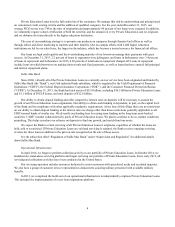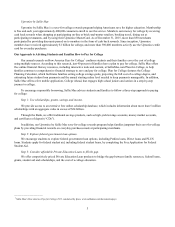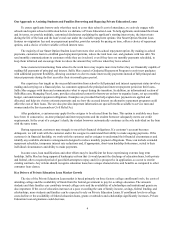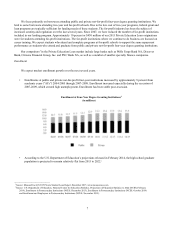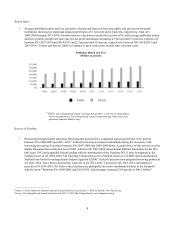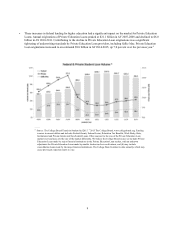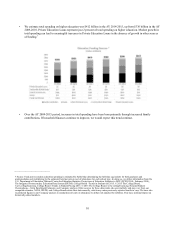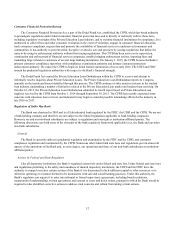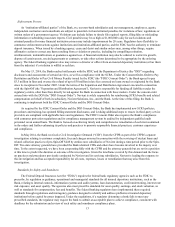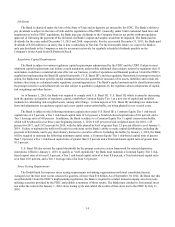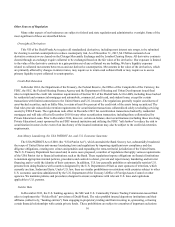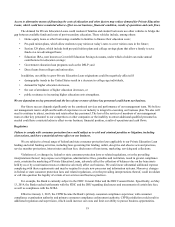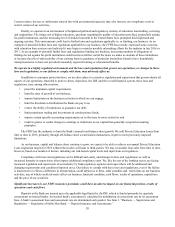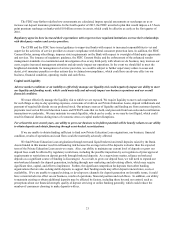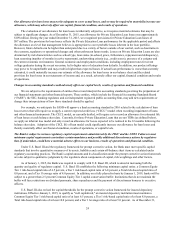Sallie Mae 2015 Annual Report Download - page 16
Download and view the complete annual report
Please find page 16 of the 2015 Sallie Mae annual report below. You can navigate through the pages in the report by either clicking on the pages listed below, or by using the keyword search tool below to find specific information within the annual report.14
Dividends
The Bank is chartered under the laws of the State of Utah and its deposits are insured by the FDIC. The Bank’s ability to
pay dividends is subject to the laws of Utah and the regulations of the FDIC. Generally, under Utah’s industrial bank laws and
regulations as well as FDIC regulations, the Bank may pay dividends to the Company from its net profits without regulatory
approval if, following the payment of the dividend, the Bank’s capital and surplus would not be impaired. The Bank paid no
dividends for the years ended December 31, 2015 and 2014, respectively. For the year ended December 31, 2013, the Bank paid
dividends of $120 million to an entity that is now a subsidiary of Navient. For the foreseeable future, we expect the Bank to
only pay dividends to the Company as may be necessary to provide for regularly scheduled dividends payable on the
Company’s Series A and Series B Preferred Stock.
Regulatory Capital Requirements
The Bank is subject to various regulatory capital requirements administered by the FDIC and the UDFI. Failure to meet
minimum capital requirements can initiate certain mandatory and possibly additional discretionary actions by regulators that, if
undertaken, could have a material adverse effect on our business, results of operations and financial position. Under the FDIC’s
regulations implementing the Basel III capital framework (“U.S. Basel III”) and the regulatory framework for prompt corrective
action, the Bank must meet specific capital standards that involve quantitative measures of its assets, liabilities and certain off-
balance sheet items as calculated under regulatory accounting practices. The Bank’s capital amounts and its classification under
the prompt corrective action framework are also subject to qualitative judgments by the regulators about components of capital,
risk weightings and other factors.
As of January 1, 2015, the Bank was required to comply with U.S. Basel III. U.S. Basel III, which is aimed at increasing
both the quantity and quality of regulatory capital, establishes Common Equity Tier 1 as a new tier of capital and modifies
methods for calculating risk-weighted assets, among other things. Certain aspects of U.S. Basel III, including new deductions
from and adjustments to regulatory capital and a new capital conservation buffer, are being phased in over several years.
The Bank is subject to the following minimum capital ratios under U.S. Basel III: a Common Equity Tier 1 risk-based
capital ratio of 4.5 percent, a Tier 1 risk-based capital ratio of 6.0 percent, a Total risk-based capital ratio of 8.0 percent, and a
Tier 1 leverage ratio of 4.0 percent. In addition, the Bank is subject to a Common Equity Tier 1 capital conservation buffer,
which will be phased in over three years beginning January 1, 2016: 0.625 percent of risk-weighted assets for 2016, 1.25
percent for 2017, and 1.875 percent for 2018, with the fully phased-in level of greater than 2.5 percent effective as of January 1,
2019. Failure to maintain the buffer will result in restrictions on the Bank’s ability to make capital distributions, including the
payment of dividends, and to pay discretionary bonuses to executive officers. Including the buffer, by January 1, 2019, the Bank
will be required to maintain the following minimum capital ratios: a Common Equity Tier 1 risk-based capital ratio of greater
than 7.0 percent, a Tier 1 risk-based capital ratio of greater than 8.5 percent and a Total risk-based capital ratio of greater than
10.5 percent.
U.S. Basel III also revised the capital thresholds for the prompt corrective action framework for insured depository
institutions. Effective January 1, 2015, to qualify as "well capitalized," the Bank must maintain a Common Equity Tier 1 risk-
based capital ratio of at least 6.5 percent, a Tier 1 risk-based capital ratio of at least 8.0 percent, a Total risk-based capital ratio
of at least 10.0 percent, and a Tier 1 leverage ratio of at least 5.0 percent.
Stress Testing Requirements
The Dodd-Frank Act imposes stress testing requirements on banking organizations with total consolidated assets,
averaged over the four most recent consecutive quarters, of more than $10 billion. As of September 30, 2014, the Bank met this
asset threshold. Under the FDIC’s implementing regulations, the Bank is required to conduct annual company-run stress tests
utilizing scenarios provided by the FDIC and publish a summary of those results. The Bank must conduct its first annual stress
test under the rules in the January 1, 2016 stress testing cycle and submit the results of that stress test to the FDIC by July 31,
2016.


